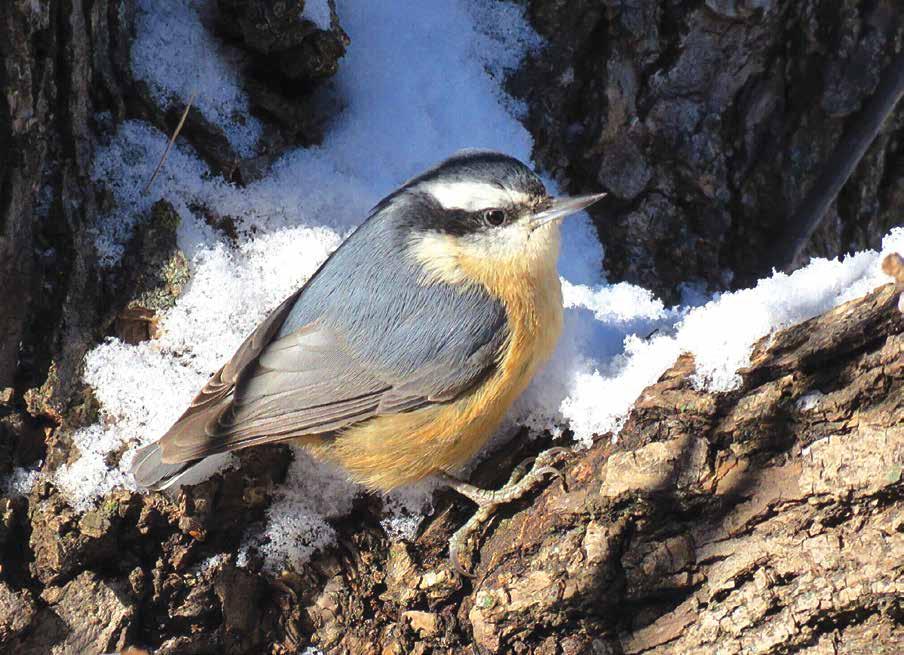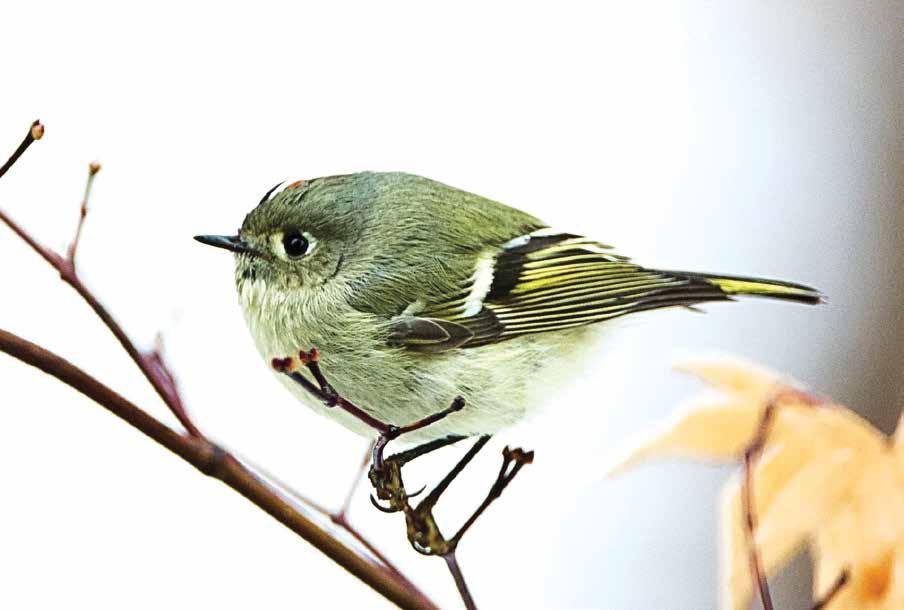
5 minute read
Take Time to Enjoy the Birds
New Year’s Resolution Take Time to Enjoy the Birds!
Above: Tiny, hyperactive Ruby-crowned Kinglets bounce through the trees alongside chickadees and titmice.
In 2018, the Americas celebrated a “Year of the Bird” coinciding with the 100th anniversary of the Migratory Bird Treaty Act. This legislation protected songbirds and game birds from unregulated hunting and collecting. “YB” events raised awareness of current threats to birds: habitat loss, window collisions, and more. Simultaneously, it was a joyful celebration of birds and our relationships with them— and emphasized the need for continued protection.
Revisiting that theme, I’ll (unofficially) designate 2023 as a “Year With the Birds.” My columns will focus on “bird appreciation,” describing birds’ seasonal activities and providing tips on observation and identification.
The Benefits of Binoculars
Some people reject binoculars due to prior frustration with them. Some feel they’re unnecessary for casual birders. But optics enhance your enjoyment, allowing you to positively identify unusual birds, closely study behavior, and admire the variations of beaks, feathers, and color patterns. With patience, almost everyone can use them effectively.
Carefully choosing your best pair of binoculars (“bins”) will allow for years of trouble-free service. Post-holiday sales provide economical options. Today’s economy binoculars offer the performance of some “high-end” bins of 30 or 40 years ago. If you’ve only used grandpa’s old bins, you’ll be amazed by the light weight and sharp viewing afforded by current models.
Peruse National Audubon Society’s excellent “Binocular Guide” (www.audubon.org/gear/binocularguide) prior to purchase. Bins are reviewed in six ascending price ranges, and don’t miss “How to Choose Your Binoculars,” a concise essay explaining what the numbers on binoculars mean and how they work. Generally, 7 or 8x magnification models serve well at home and afield; or, combine birding and gardening pleasures with a compact pair tucked in your pocket!
Beginners often obsess about identifying birds, but their goal should be mastering their bins! Every pair requires a simple (but essential) 4-step adjustment to accommodate your particular vision. Don’t skip the enclosures, which provide use and care tips. Once adjusted, the key to success is: PRACTICE! Hone your skills by focusing quickly on perching birds and following them as they move from feeder to tree to ground, and you’ll rapidly improve.
Watching in a Winter Wonderland
Only the hardiest birds remain now. Summer’s territorial disputes forgotten, our “old friends” forage and evade predators in mixed flocks. I affectionately call these “chickatithatchwrenlets,” after some of their members: Black-capped Chickadees, Tufted Titmouse, White-breasted Nuthatches, Carolina Wrens, Ruby-crowned and Golden-crowned Kinglets. Cardinals, House Finches, and woodpeckers (Downy, Hairy, Red-bellied) complete the cast. Chickadees and titmice are indispensable to a flock, often being the first to discover food sources and potential predators. Titmice call “peter-peter-peter” and (continued on page 12)
ELIZABETH STOAKES Birding Enthusiast
Elizabeth Stoakes is currently President of Burroughs Audubon Society in Kansas City and has been birding for over 25 years. Please contact BAS via mail@burroughs.org or text/call 816-795-8177 with any birding questions.

Photo courtesy of Tom Tucker.
Above: This is an adult White-crowned Sparrow.
Below: This Red Crossbill (male) shows off his specialized beak.
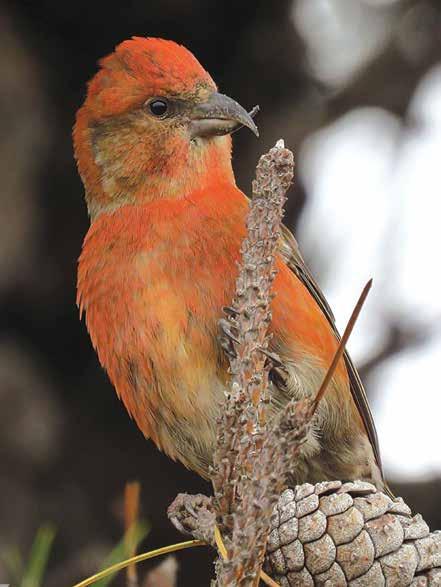
Photo courtesy of Rodney Wright. Above: An American Goldfinch displays its subdued yellowish-green winter plumage.
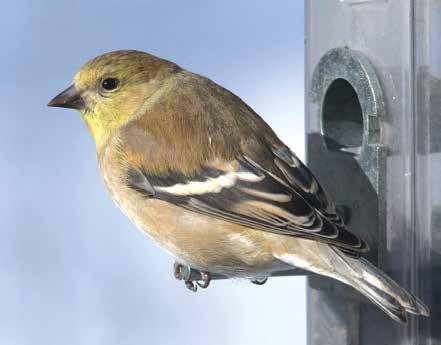

Above: A young Cooper’s Hawk takes a break from hunting.
Below: Dark-eyed Juncos are one of our most numerous and recognizable winter sparrows.

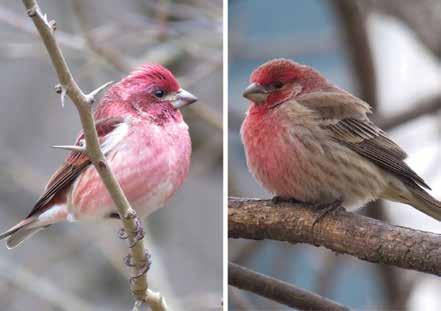
Photo courtesy of Rodney Wright.
Above: Brown streaks and red to orange color distinguish a House Finch (right) from a Purple Finch (left).
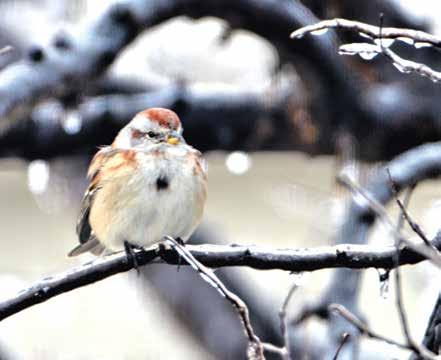
Photo courtesy of Tom Tucker.
Above: American Tree Sparrows sport a handsome reddish crown and distinctive black “stickpin” on their breasts.
Below: Yellow-bellied Sapsuckers love suet as much as any other woodpeckers.

Photo courtesy of Terrence Thompson. Above: Adult Male Harris’s Sparrow showing black bib and light colored bill.
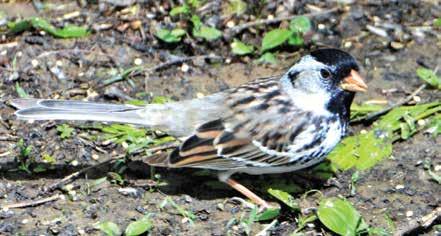
Below: The rich red color of a Fox Sparrow brightens any winter day.
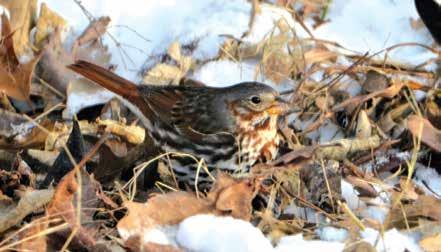
(continued from page 11) make scratchy, nasal sounds. Note that the chickadee’s “chick-a-deedee-dee” call is more rapid and urgent if threats appear. A human might rate a few “dees,” but a Cooper’s Hawk will detonate a frantic barrage of sound! If birds vocalize, or suddenly disappear into cover, scan your surroundings—you may spot a hunting hawk or resting owl.
Winter is our “season of sparrows.” About a dozen of our 21 species are winter residents. Song Sparrows (with thick brown streaks and “mustaches”) remain all year. White-throated, White-crowned, American Tree, Fox, and Harris’s Sparrows, and Dark-eyed Juncos, descend from northern latitudes in fall and we savor their subtle beauty until spring. These durable ground feeders are easily attracted by a little millet, nearby shrubby cover, and water. House Sparrows rarely deter them.
Sorting species provides enjoyable challenges. The White-throated Sparrow may sport white or tan crown stripes. Harris’s Sparrows with their pink bills and dark bib are sometimes mistaken for House Sparrows. Adult White-crowned Sparrows wear a striking black and white cap, while young birds’ crowns are chestnut and gray. Behavior gives important clues. When fallen leaves “churn,” look for juncos, White-throated and Fox Sparrows, which often forage like chickens. American Tree Sparrows, with black breast spots and reddish caps, are shy and like roosting in brush piles apart from other birds.
Guess Who’s Coming to Dinner
Winter brings the special joy of unexpected “irruptive” species. These birds wander widely, appearing when food supplies are depleted elsewhere. This year, watch for Purple Finches, Red-breasted Nuthatches, and even some longawaited Red Crossbills! Crossbills are specialist feeders that use scissor-like bills to extract seeds from pine cones. You may have to venture afield to see these unique visitors—eBird.org can lead you to recent sightings.
Tracking population trends is vital to bird conservation. Several long-running community science projects allow everyone to participate. Please Google Project Feederwatch, Great Backyard Bird Count, and eBird for more information and enjoy your winter birds!
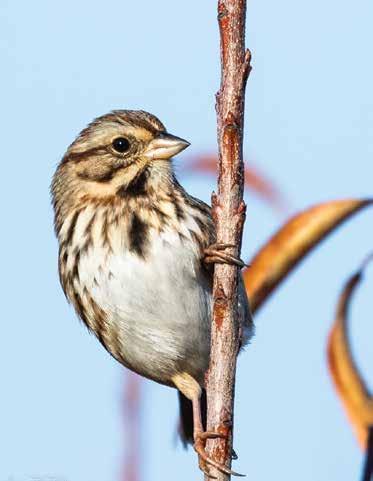
Photo courtesy of Terrence Thompson. Photo courtesy of Terrence Thompson.
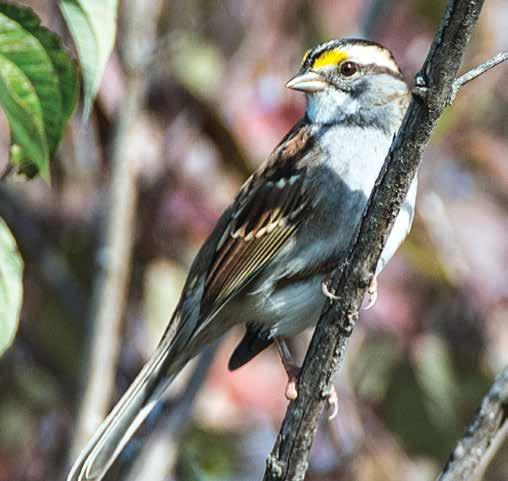
Above left: Song Sparrow markings are easy to see. Above right: Bright yellow facial spots distinguish the White-throated Sparrow.
Below: Red-breasted Nuthatches are irregular winter visitors to our area.
